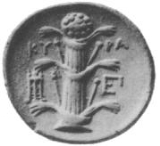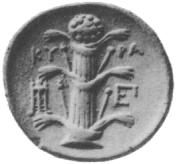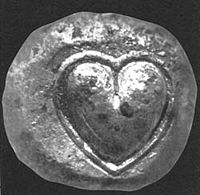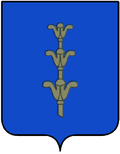
Silphium
Encyclopedia

Classical antiquity
Classical antiquity is a broad term for a long period of cultural history centered on the Mediterranean Sea, comprising the interlocking civilizations of ancient Greece and ancient Rome, collectively known as the Greco-Roman world...
as a rich seasoning and as a medicine. It was the essential item of trade from the ancient North African city of Cyrene
Cyrene, Libya
Cyrene was an ancient Greek colony and then a Roman city in present-day Shahhat, Libya, the oldest and most important of the five Greek cities in the region. It gave eastern Libya the classical name Cyrenaica that it has retained to modern times.Cyrene lies in a lush valley in the Jebel Akhdar...
, and was so critical to the Cyrenian economy that most of their coin
Coin
A coin is a piece of hard material that is standardized in weight, is produced in large quantities in order to facilitate trade, and primarily can be used as a legal tender token for commerce in the designated country, region, or territory....
s bore a picture of the plant (illustration, right). The valuable product was the plant's resin
Resin
Resin in the most specific use of the term is a hydrocarbon secretion of many plants, particularly coniferous trees. Resins are valued for their chemical properties and associated uses, such as the production of varnishes, adhesives, and food glazing agents; as an important source of raw materials...
(laser, laserpicium, or lasarpicium).
Aside from its uses in Greco-Roman cooking (as in recipes by Apicius
Apicius
Apicius is the title of a collection of Roman cookery recipes, usually thought to have been compiled in the late 4th or early 5th century AD and written in a language that is in many ways closer to Vulgar than to Classical Latin....
), many medical uses were ascribed to the plant. It was said that it could be used to treat cough, sore throat, fever
Fever
Fever is a common medical sign characterized by an elevation of temperature above the normal range of due to an increase in the body temperature regulatory set-point. This increase in set-point triggers increased muscle tone and shivering.As a person's temperature increases, there is, in...
, indigestion, aches and pains, warts, and all kinds of maladies. It has been speculated that the plant may also have functioned as a contraceptive, based partly on Pliny's statement that it could be used "to promote the menstrual discharge". Given that many species in the parsley family
Apiaceae
The Apiaceae , commonly known as carrot or parsley family, is a group of mostly aromatic plants with hollow stems. The family is large, with more than 3,700 species spread across 434 genera, it is the sixteenth largest family of flowering plants...
have estrogen
Estrogen
Estrogens , oestrogens , or œstrogens, are a group of compounds named for their importance in the estrous cycle of humans and other animals. They are the primary female sex hormones. Natural estrogens are steroid hormones, while some synthetic ones are non-steroidal...
ic properties, and some (such as wild carrot
Wild carrot
Daucus carota is a flowering plant in the family Apiaceae, native to temperate regions of Europe, southwest Asia and naturalised to northeast North America and Australia; domesticated carrots are cultivars of a subspecies, Daucus carota subsp...
) have been found to work as an abortifacient
Abortifacient
An abortifacient is a substance that induces abortion. Abortifacients for animals that have mated undesirably are known as mismating shots....
, it is quite possible that the plant was pharmacologically active in the prevention or termination of pregnancy.
Silphium was an important species
Species
In biology, a species is one of the basic units of biological classification and a taxonomic rank. A species is often defined as a group of organisms capable of interbreeding and producing fertile offspring. While in many cases this definition is adequate, more precise or differing measures are...
in prehistory
Prehistory
Prehistory is the span of time before recorded history. Prehistory can refer to the period of human existence before the availability of those written records with which recorded history begins. More broadly, it refers to all the time preceding human existence and the invention of writing...
, as evidenced by the Egyptians
Ancient Egypt
Ancient Egypt was an ancient civilization of Northeastern Africa, concentrated along the lower reaches of the Nile River in what is now the modern country of Egypt. Egyptian civilization coalesced around 3150 BC with the political unification of Upper and Lower Egypt under the first pharaoh...
and Knossos
Knossos
Knossos , also known as Labyrinth, or Knossos Palace, is the largest Bronze Age archaeological site on Crete and probably the ceremonial and political centre of the Minoan civilization and culture. The palace appears as a maze of workrooms, living spaces, and store rooms close to a central square...
Minoan
Minoan civilization
The Minoan civilization was a Bronze Age civilization that arose on the island of Crete and flourished from approximately the 27th century BC to the 15th century BC. It was rediscovered at the beginning of the 20th century through the work of the British archaeologist Arthur Evans...
s developing a specific glyph
Glyph
A glyph is an element of writing: an individual mark on a written medium that contributes to the meaning of what is written. A glyph is made up of one or more graphemes....
to represent the silphium plant. It was used widely by most ancient Mediterranean cultures; the Romans considered it "worth its weight in denarii
Denarius
In the Roman currency system, the denarius was a small silver coin first minted in 211 BC. It was the most common coin produced for circulation but was slowly debased until its replacement by the antoninianus...
" (silver coin
Silver coin
Silver coins are possibly the oldest mass produced form of coinage. Silver has been used as a coinage metal since the times of the Greeks. Their silver drachmas were popular trade coins....
s). Legend said that it was a gift from the god Apollo
Apollo
Apollo is one of the most important and complex of the Olympian deities in Greek and Roman mythology...
.
The exact identity of silphium is unclear. It is commonly believed to be a now-extinct
Extinction
In biology and ecology, extinction is the end of an organism or of a group of organisms , normally a species. The moment of extinction is generally considered to be the death of the last individual of the species, although the capacity to breed and recover may have been lost before this point...
plant of the genus
Genus
In biology, a genus is a low-level taxonomic rank used in the biological classification of living and fossil organisms, which is an example of definition by genus and differentia...
Ferula
Ferula
Ferula is a genus of about 170 species of flowering plants in the family Apiaceae, native to the Mediterranean region east to central Asia, mostly growing in arid climates. They are herbaceous perennial plants growing to 1–4 m tall, with stout, hollow, somewhat succulent stems...
, perhaps a variety of "giant fennel". The still-extant plant Ferula tingitana
Ferula tingitana
Ferula tingitana is a species of the Apiaceae genus Ferula. Despite the name, the plant is not a type of fennel proper, which belongs to another genus .Ferula tingitana is a tall perennial herb...
has been suggested as another possibility. Another plant, asafoetida
Asafoetida
Asafoetida , alternative spelling asafetida, is the dried latex exuded from the living underground rhizome or tap root of several species of Ferula, which is a perennial herb...
, was used as a cheaper substitute for silphium, and had similar enough qualities that Romans, including the geographer Strabo
Strabo
Strabo, also written Strabon was a Greek historian, geographer and philosopher.-Life:Strabo was born to an affluent family from Amaseia in Pontus , a city which he said was situated the approximate equivalent of 75 km from the Black Sea...
, used the same word to describe both.
Identity and extinction
The identity of silphium is highly debated. It is generally considered to belong to the genus Ferula, probably as an extinct species (although the currently extant plants Ferula tingitanaFerula tingitana
Ferula tingitana is a species of the Apiaceae genus Ferula. Despite the name, the plant is not a type of fennel proper, which belongs to another genus .Ferula tingitana is a tall perennial herb...
, Ferula narthex, and Thapsia garganica have historically been suggested as possible identities). K. Parejko, writing on its possible extinction, concludes that "because we cannot even accurately identify the plant we cannot know for certain whether it is extinct."
The cause of silphium's supposed extinction is not entirely known. The plant grew along a narrow coastal area, about 125 by 35 miles, in Cyrenaica
Cyrenaica
Cyrenaica is the eastern coastal region of Libya.Also known as Pentapolis in antiquity, it was part of the Creta et Cyrenaica province during the Roman period, later divided in Libia Pentapolis and Libia Sicca...
(in present-day Libya
Libya
Libya is an African country in the Maghreb region of North Africa bordered by the Mediterranean Sea to the north, Egypt to the east, Sudan to the southeast, Chad and Niger to the south, and Algeria and Tunisia to the west....
). Much of the speculation about the cause of its extinction rests on a sudden demand for animals that grazed on the plant, for some supposed effect on the quality of the meat. Overgrazing
Overgrazing
Overgrazing occurs when plants are exposed to intensive grazing for extended periods of time, or without sufficient recovery periods. It can be caused by either livestock in poorly managed agricultural applications, or by overpopulations of native or non-native wild animals.Overgrazing reduces the...
combined with overharvesting may have led to its extinction. The climate of the Maghreb
Maghreb
The Maghreb is the region of Northwest Africa, west of Egypt. It includes five countries: Morocco, Algeria, Tunisia, Libya, and Mauritania and the disputed territory of Western Sahara...
has been drying over the millennia, and desertification
Desertification
Desertification is the degradation of land in drylands. Caused by a variety of factors, such as climate change and human activities, desertification is one of the most significant global environmental problems.-Definitions:...
may also have been a factor. Another theory is that when Roman
Ancient Rome
Ancient Rome was a thriving civilization that grew on the Italian Peninsula as early as the 8th century BC. Located along the Mediterranean Sea and centered on the city of Rome, it expanded to one of the largest empires in the ancient world....
provincial governors took over power from Greek colonists, they over-farmed silphium and rendered the soil unable to yield the type that was said to be of such medicinal value. Theophrastus
Theophrastus
Theophrastus , a Greek native of Eresos in Lesbos, was the successor to Aristotle in the Peripatetic school. He came to Athens at a young age, and initially studied in Plato's school. After Plato's death he attached himself to Aristotle. Aristotle bequeathed to Theophrastus his writings, and...
reports that the type of ferula specifically referred to as "silphium" was odd in that it only grew in the wild, and could not be successfully grown as a crop in tilled soil. The validity of this report is questionable, however, as Theophrastus was merely passing on a report from another source. Pliny reported that the last known stalk of silphium found in Cyrenaica was given to the Emperor Nero
Nero
Nero , was Roman Emperor from 54 to 68, and the last in the Julio-Claudian dynasty. Nero was adopted by his great-uncle Claudius to become his heir and successor, and succeeded to the throne in 54 following Claudius' death....
"as a curiosity".
Silphium retained a ghostly literary half-life in lists of aromatics copied one from another, until it makes perhaps its last, spectral appearance in the list of spices that the Carolingian
Carolingian
The Carolingian dynasty was a Frankish noble family with origins in the Arnulfing and Pippinid clans of the 7th century AD. The name "Carolingian", Medieval Latin karolingi, an altered form of an unattested Old High German *karling, kerling The Carolingian dynasty (known variously as the...
cook should have at hand— Brevis pimentorum que in domo esse debeant ("A short list of condiments that should be in the home") — by a certain "Vinidarius", whose excerpts of Apicius survive in one eighth-century uncial
Uncial
Uncial is a majuscule script commonly used from the 3rd to 8th centuries AD by Latin and Greek scribes. Uncial letters are written in either Greek, Latin, or Gothic.-Development:...
manuscript. Vinidarius's dates may not be much earlier.
Connection with the heart symbol

Heart (symbol)
The heart has long been used as a symbol to refer to the spiritual, emotional, moral, and in the past, also intellectual core of a human being...
shape (♥). The symbol is remarkably similar to the Egypt
Egypt
Egypt , officially the Arab Republic of Egypt, Arabic: , is a country mainly in North Africa, with the Sinai Peninsula forming a land bridge in Southwest Asia. Egypt is thus a transcontinental country, and a major power in Africa, the Mediterranean Basin, the Middle East and the Muslim world...
ian "heart soul" (ib). The sexual nature of that concept, combined with the widespread use of silphium in ancient Egypt for birth control, and the fact that silphium seed
Seed
A seed is a small embryonic plant enclosed in a covering called the seed coat, usually with some stored food. It is the product of the ripened ovule of gymnosperm and angiosperm plants which occurs after fertilization and some growth within the mother plant...
s were heart-shaped, leads to speculation that the character for ib may have been derived from the shape of the silphium seed.
Contemporary writings help tie silphium to sexuality
Human sexuality
Human sexuality is the awareness of gender differences, and the capacity to have erotic experiences and responses. Human sexuality can also be described as the way someone is sexually attracted to another person whether it is to opposite sexes , to the same sex , to either sexes , or not being...
and love. Silphium appears in Pausanias'
Pausanias (geographer)
Pausanias was a Greek traveler and geographer of the 2nd century AD, who lived in the times of Hadrian, Antoninus Pius and Marcus Aurelius. He is famous for his Description of Greece , a lengthy work that describes ancient Greece from firsthand observations, and is a crucial link between classical...
Description of Greece in a story of the Dioscuri staying at a house belonging to Phormion a Spartan, "For it so happened that his maiden daughter was living in it. By the next day this maiden and all her girlish apparel had disappeared, and in the room were found images of the Dioscuri, a table, and silphium upon it."
Silphium as Laserpicium makes an appearance in a poem (Catullus 7) of Catullus
Catullus
Gaius Valerius Catullus was a Latin poet of the Republican period. His surviving works are still read widely, and continue to influence poetry and other forms of art.-Biography:...
to his lover Lesbia
Lesbia
Lesbia was the literary pseudonym of the great love of Roman poet Gaius Valerius Catullus .She was a poet in her own right, included with Catullus in a list of famous poets whose lovers "often" helped them write their verses....
(though others have suggested that the reference here is instead to silphium's use as a treatment for mental illness, tying it to the 'madness' of love).
Heraldry

Heraldry
Heraldry is the profession, study, or art of creating, granting, and blazoning arms and ruling on questions of rank or protocol, as exercised by an officer of arms. Heraldry comes from Anglo-Norman herald, from the Germanic compound harja-waldaz, "army commander"...
, Il silfio d’oro reciso di Cirenaica (silphium couped or
Or (heraldry)
In heraldry, Or is the tincture of gold and, together with argent , belongs to the class of light tinctures called "metals". In engravings and line drawings, it may be represented using a field of evenly spaced dots...
of Cyrenaica) was the symbol granted to the units that fought in the campaigns in North Africa during World War II.
Modern references
A fruitless search for silphium by Romans in the reign of the emperor VespasianVespasian
Vespasian , was Roman Emperor from 69 AD to 79 AD. Vespasian was the founder of the Flavian dynasty, which ruled the Empire for a quarter century. Vespasian was descended from a family of equestrians, who rose into the senatorial rank under the Emperors of the Julio-Claudian dynasty...
is an amusing sub-plot of the crime novel Two for the Lions
Two for the Lions
-Plot introduction:Set in Rome and Tripolitania between December AD 73 and May AD 74, Two for the Lions stars Marcus Didius Falco, Informer and Imperial Agent...
by Lindsey Davis
Lindsey Davis
Lindsey Davis is an English historical novelist, best known as the author of the Falco series of crime stories set in ancient Rome and its empire.-Biography:...
.
Further reading
- Buttrey, T. V. (1997). "Part I: The Coins from the Sanctuary of Demeter and Persephone". In
- William Turner, A New Herball (1551, 1562, 1568)
External links
- David W. Tschanz; "Ancient Herbal Contraception"
- Silphium and Ancient Roman Cookery at Gernot Katzer's Spice Pages
- The Secret of the Heart
- The Straight Dope on Silphium

